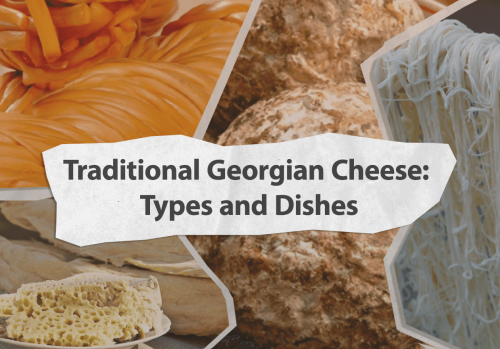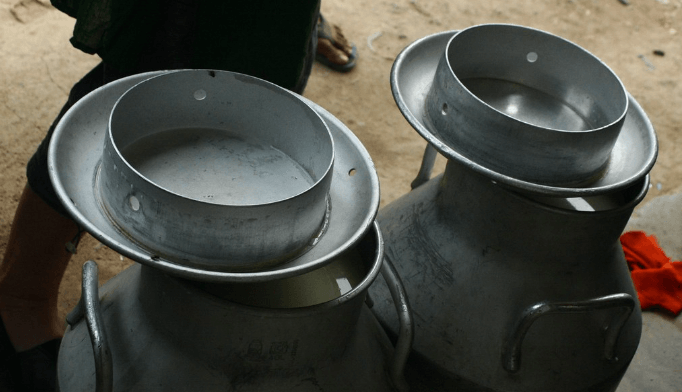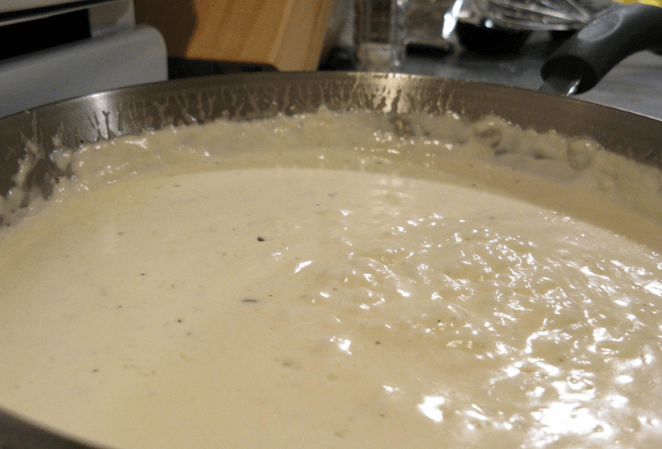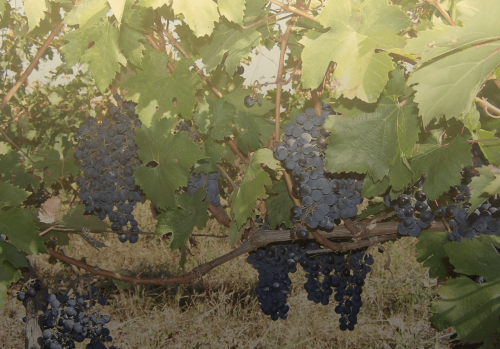Traditional Georgian Cheese - Types and Dishes

Before we start, Check out our Khachapuri Masterclass
What is your favorite cheese? As we know, there are many types of cheese, which have different cooking cultures and histories. It should be noted that Georgia has a culture of cheese making for centuries, and also, every region has its own way of making cheese, for example, Imereti is famous for its Imerian cheese, Samegrelo for Sulgun, and in the mountains you will find Gudi cheese.
In the article, we will discuss many types of Georgian cheese, and you can decide for yourself whether it is worth tasting them, but believe us, it is worth it.
Types of Georgian Traditional Cheese
We will discuss all the regions of Georgia and discuss their characteristic cheeses, cooking methods and tastes.
1. Sulguni
.png)
A semi-soft cheese with a tangy flavor, Sulguni is one of the most famous Georgian cheeses. It is typically made from cow's milk and has a stringy, elastic texture, making it a perfect choice for grilling or frying.
2. Imeruli
.png) source: Food Perestroika
source: Food Perestroika
Similar to Sulguni, Imeruli is another popular type of Georgian cheese made from cow's milk. It is a soft and stretchy cheese, commonly used in dishes like khachapuri (Georgian cheese-filled bread) and salads.
3. Guda
.png)
This cheese is made from sheep's milk and has a slightly salty taste. It comes in various shapes, and the most traditional one is a rolled-up ball.
4. Tenili

Also known as "string cheese," Tenili is a pulled-curd cheese made from cow's milk. It has a delicate texture and is often served as a snack or appetizer.
5. Karkhunili

This cheese is made from a combination of cow and sheep's milk. It has a soft and creamy texture with a distinctive taste.
6. Dambal-khacho (georgian journal)
.png) picture from: Georgian Journal
picture from: Georgian Journal
This unique Georgian cheese is produced using a special technique. It involves filling the skin of a sheep or goat with curds and then hanging it in a warm place to age and ferment. The resulting cheese is strong and pungent.
7. Chechili
 source: Gastronomia
source: Gastronomia
Also called "red cheese," Chechili gets its name from the red chili pepper used during its production. It is a spicy and flavorful cheese made from cow's milk.
These are just a few examples of the many delicious and diverse Georgian cheeses. Each region and sub-region in Georgia has its own cheese-making techniques and specialties, contributing to the country's rich culinary heritage.
How Georgian Traditional cheese is made?
The traditional method of making Georgian cheese involves a few key steps. The process may vary slightly depending on the specific type of cheese being produced, but here is a general overview of how Georgian cheese is made step-by-step.
-
Milk Collection - The cheese-making process begins with collecting fresh milk. Georgian cheese is commonly made from cow's, sheep's, or goat's milk, or a combination of these.

-
Coagulation - The collected milk is heated and then coagulated using either animal rennet (enzymes from the stomach lining of young animals) or a starter culture. The coagulation process causes the milk to thicken and form curds.

-
Cutting the Curds - Once the curds have formed, they are cut into smaller pieces to release whey, the liquid part of the milk. The size of the curds will depend on the type of cheese being made and the desired texture.

-
Cooking and Stirring - The curds are then gently cooked while being stirred. The cooking process helps expel more whey and control the final moisture content of the cheese.

-
Draining - After cooking, the curds are left to drain, allowing more whey to separate from the solid curds. The whey can be saved and used for other purposes, such as making whey-based beverages or baking.

-
Salting - The cheese is then salted either by soaking it in brine or by dry salting. Salt helps preserve the cheese, enhances flavor, and affects the texture.

-
Aging - After salting, the cheese is left to age in a controlled environment. The aging process can range from a few days to several months or even years, depending on the type of cheese. During aging, the cheese develops its unique flavor, aroma, and texture.

-
Packaging - Once the cheese has aged to the desired level, it is ready for consumption. It can be packaged in various forms, such as blocks, wheels, or grated.
It's important to note that traditional Georgian cheese-making often involves simple, time-tested techniques that have been passed down through generations. The choice of milk, coagulation method, and aging conditions all contribute to the distinct flavors and textures found in Georgian cheeses. Additionally, some cheeses may include specific ingredients like herbs, spices, or chili peppers, which add unique characteristics to the final product.
Georgian Dishes that is made of Cheese
Georgian cuisine features a variety of delicious dishes made with cheese, and many of them are centered around the iconic Georgian cheeses like Sulguni, Imeruli, and others. Here are some popular Georgian dishes that prominently feature cheese:
1. Khachapuri
Perhaps the most famous Georgian cheese dish, khachapuri is a cheese-filled bread that comes in various regional styles.

2. Chvishtari
Cornbread filled with a mixture of cheese and often butter. It's a popular comfort food in Georgia.
.png)
3. Gebjalia
A refreshing dish made of fresh cheese mixed with chopped herbs, usually cilantro, dill, and tarragon. It is served as a side dish or appetizer.
.png)
4. Khabizgina
A dish made of layers of Sulguni cheese mixed with butter and flour, then baked in the oven until crispy and golden.
.png)
5. Elarji
A unique dish made of coarse cornmeal (mchadi) mixed with Sulguni cheese and stirred until it forms a thick, gooey texture. It's typically served with meat dishes.

6. Georgian Salad with Cheese
A simple but tasty salad made of fresh tomatoes, cucumbers, onions, and bell peppers, often topped with grated or diced Georgian cheese.

These dishes are just a few examples of the many delicious ways Georgian cheese is used in their cuisine. Cheese holds a special place in Georgian culinary traditions and is celebrated in a wide variety of dishes.
The history of Georgian Cheese-making
Cheese-making in Georgia has a long and storied history, dating back thousands of years. The process of cheese-making is deeply ingrained in Georgian culture and plays a significant role in their culinary traditions. The exact origins of cheese-making in Georgia are not well-documented, but it is believed to have been practiced since ancient times.
Ancient Origins - The Caucasus region, including modern-day Georgia, is considered one of the birthplaces of cheese-making. Archaeological evidence suggests that cheese production in the region dates back to at least the 6th millennium BCE.
.png)
Throughout history, Georgians developed various traditional cheese-making techniques using the milk from their livestock, which included cows, sheep, and goats. These traditional methods have been passed down through generations and remain a vital part of Georgian culture and cuisine.
Different regions of Georgia have developed their unique cheese-making practices, leading to a diverse range of cheeses with distinct flavors and textures. Each region takes pride in its local cheese varieties and methods of production.
Cheese holds great cultural significance in Georgia. It is a staple in their everyday diet and is an integral part of traditional feasts and celebrations. Georgians often incorporate cheese into various dishes, appetizers, and desserts.
Historically, cheese-making played a crucial role in preserving dairy products for times of scarcity, such as during the harsh winters or when nomadic herders needed a portable food source.
With the advent of modern technologies and transportation, Georgian cheese production expanded and became more commercialized. Georgian cheeses are now exported and enjoyed by people around the world.
Conclusion
In conclusion, Georgian cheese-making is an ancient tradition deeply rooted in the country's culture and culinary heritage. The history of cheese-making in Georgia dates back thousands of years, making it one of the birthplaces of this art.
Visiting local markets and cheese shops allows visitors to sample different types of Georgian cheese and learn about the distinctive flavors and textures that each region offers. Additionally, exploring rural areas and agro-tourism farms provides a firsthand experience of traditional cheese-making practices and a chance to taste freshly made artisanal cheeses.
Georgian cheese holds significant cultural and culinary value, and its preservation and celebration have contributed to its inscription into UNESCO's list of Intangible Cultural Heritage. The rich cheese culture in Georgia continues to thrive, with cheese festivals and events celebrating this cherished culinary art.




